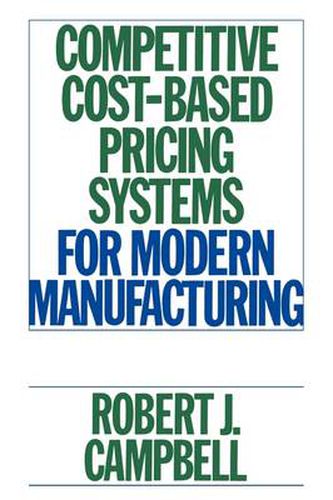Readings Newsletter
Become a Readings Member to make your shopping experience even easier.
Sign in or sign up for free!
You’re not far away from qualifying for FREE standard shipping within Australia
You’ve qualified for FREE standard shipping within Australia
The cart is loading…






In an era of fierce international competition, manufacturing firms must have a thorough understanding of their cost structure and how that structure relates to pricing and product mix decisions. Two competing conceptual approaches to designing product cost systems that support decision making are activity-based costing and the theory of constraints. Rather than argue in favour of one to the exclusion of the other, Robert J. Campbell presents a new approach to cost system design that combines the strengths of each school of thought, thereby overcoming the significant limitations of each. The need to price the product mix in order to exploit constrained resources is advocated by the theory of constraints, while the need to examine resource consumption from activities, both value adding and non-value adding, to support the principles of JIT is advocated by activity-based costing. After examining the nature of a firm’s cost structure as it relates to the activities performed by various functional areas, Campbell discusses the development of activity-based cost systems through an extensive example. Activity-based costing can lead to building excessively complex accounting sytems that lack focus and provide confusion about short-run versus long-run changes in the cost structure. After a chapter examining short-run cost behaviour and cost relationships, an in-depth discussion of the Theory of Constraints and how it is contrasted to, and complemented by, activity-based costing follows. In these middle chapters the strengths of each methodology are identified and combined into a unified approach to product cost systems. Later chapters provide discussion on pricing strategies, customer profitability analysis, and providing cost measures that recognise either loss of learning or volume-related efficiencies in machine-paced organisations. This book should an important resource for executives or consultants seeking to implement new cost management systems that lead to improved decision-making, as well as for educators seeking to reconcile and understand activity-based costing and theory of constraints.
$9.00 standard shipping within Australia
FREE standard shipping within Australia for orders over $100.00
Express & International shipping calculated at checkout
In an era of fierce international competition, manufacturing firms must have a thorough understanding of their cost structure and how that structure relates to pricing and product mix decisions. Two competing conceptual approaches to designing product cost systems that support decision making are activity-based costing and the theory of constraints. Rather than argue in favour of one to the exclusion of the other, Robert J. Campbell presents a new approach to cost system design that combines the strengths of each school of thought, thereby overcoming the significant limitations of each. The need to price the product mix in order to exploit constrained resources is advocated by the theory of constraints, while the need to examine resource consumption from activities, both value adding and non-value adding, to support the principles of JIT is advocated by activity-based costing. After examining the nature of a firm’s cost structure as it relates to the activities performed by various functional areas, Campbell discusses the development of activity-based cost systems through an extensive example. Activity-based costing can lead to building excessively complex accounting sytems that lack focus and provide confusion about short-run versus long-run changes in the cost structure. After a chapter examining short-run cost behaviour and cost relationships, an in-depth discussion of the Theory of Constraints and how it is contrasted to, and complemented by, activity-based costing follows. In these middle chapters the strengths of each methodology are identified and combined into a unified approach to product cost systems. Later chapters provide discussion on pricing strategies, customer profitability analysis, and providing cost measures that recognise either loss of learning or volume-related efficiencies in machine-paced organisations. This book should an important resource for executives or consultants seeking to implement new cost management systems that lead to improved decision-making, as well as for educators seeking to reconcile and understand activity-based costing and theory of constraints.